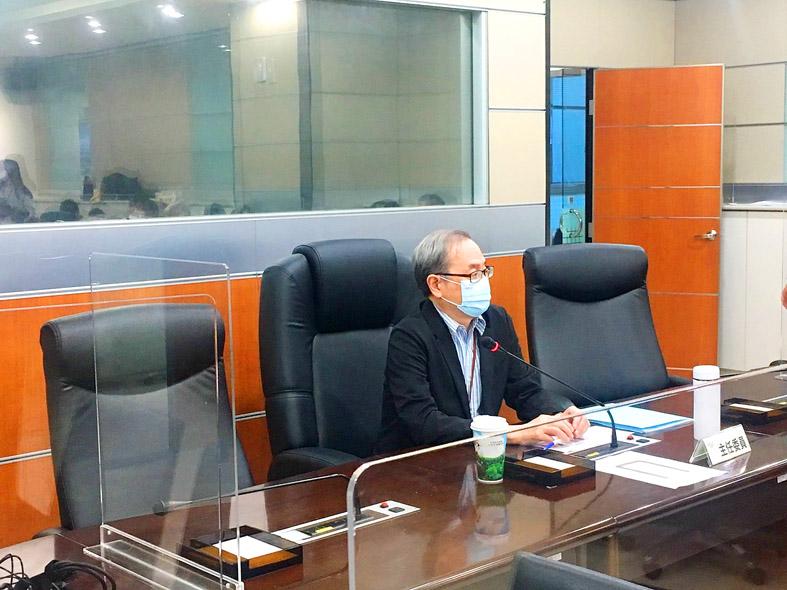The Atomic Energy Council (AEC) is planning to spend more than NT$500 million (US$17.77 million) on early warning, monitoring and research activities focused on the waters around Taiwan, the council said yesterday.
The statement came after Japan on Tuesday last week announced that it plans to release processed wastewater from the wrecked Fukushima Dai-ichi nuclear power plant into the ocean in several years.
However, the council said that it had made preparations for such a move ahead of Tokyo’s announcement.

Photo: Yang Mian-chieh, Taipei Times
Four years ago, its Radiation Monitoring Center was tasked with monitoring the waters, while a three-pronged strategy would be adopted in the future, the council said.
These would include cooperation with the Ocean Affairs Council to establish an early warning system and the development of monitoring technology to more precisely assess ocean currents, the council said, adding that the measures would cost about NT$128 million and be in place in about one-and-a-half years.
Once that infrastructure is set up, the council would in a four-year program monitor the situation and conduct research, and publish a comprehensive environmental impact assessment, the council said.
These measures would cost NT$400 million to NT$500 million, it said.
The council would also increase the number of offshore radioactivity detectors, it said.
Thirty-three detectors are in operation, and another 62 are to be created by the Fisheries Research Institute before the end of this year, it said.
The council would also seek cooperation with International Atomic Energy Agency (IAEA) investigators, it said.
As China is a member of the international body, it would be difficult for Taiwan to join, AEC Minister Hsieh Shou-shing (謝曉星) said.
The council would try its best to participate in the investigation team and monitor nearby waters, he added.
In case the IAEA rejects Taiwan’s bid, he hopes that the agency would share data from its monitoring operations with the nation, Hsieh said.
Wastewater from the Fukushima Dai-ichi plant is to be diluted to 1,500 becquerels of tritium per liter before it is discharged, Hsieh said, adding that it is within the limits set by the IAEA.
The human body would be able to process that amount within one month, he said.
However, a continuous risk assessment is needed, Hsieh said, reiterating that he opposes Japan’s plan.
People who are concerned that fish might contain radionuclides should not consume it, Hsieh said.
In related news, a simulation developed by a team led by Ho Chung-ru (何宗儒), a professor in National Taiwan Ocean University’s Department of Marine Environmental Information, showed that daily discharges of wastewater at the plant would have a 1 percent chance of affecting the waters near Taiwan, while it would take just one and a half years, at the earliest, for it to possibly affect Taiwan’s offshore waters.
The actual spread of the wastewater — including the range and speed — would depend on factors including the location of its release and the climate, the university said.

A strong continental cold air mass is to bring pollutants to Taiwan from tomorrow, the Ministry of Environment said today, as it issued an “orange” air quality alert for most of the country. All of Taiwan except for Hualien and Taitung counties is to be under an “orange” air quality alert tomorrow, indicating air quality that is unhealthy for sensitive groups. In China, areas from Shandong to Shanghai have been enveloped in haze since Saturday, the ministry said in a news release. Yesterday, hourly concentrations of PM2.5 in these areas ranged from 65 to 160 micrograms per cubic meter (mg/m³), and pollutants were

Taiwan’s armed forces have established response protocols for a wide range of sudden contingencies, including the “Wan Chun Plan” to protect the head of state, the Ministry of Defense (MND) said today. After US President Donald Trump on Saturday launched a series of airstrikes in Venezuela and kidnapped Venezuelan President Nicolas Maduro, concerns have been raised as to whether China would launch a similar “decapitation strike” on Taiwan. The armed forces regularly coordinate with relevant agencies and practice drills to ensure preparedness for a wide range of scenarios, Vice Minister of National Defense Hsu Szu-chien (徐斯儉) told reporters before a

EVA Airways on Saturday said that it had suspended a pilot and opened an investigation after he allegedly lost his temper and punched the first officer several times as their plane was taxiing before takeoff at Los Angeles International Airport. According to a report published on Thursday by The Reporter, the incident occurred after the flight’s Malaysian first officer tried to warn the Taiwanese pilot, surnamed Wen (文), that he was taxiing faster than the speed limit of 30 knots (55.6kph). After alerting the pilot several times without response, the first officer manually applied the brakes in accordance with standard operating

NOT AN OPENING: Trump’s violation of international law does not affect China’s consideration in attacking Taiwan; Beijing lacks capability, not precedent, an official said Taiwanese officials see the US’ capture of the president of Venezuela as a powerful deterrent to Beijing’s aggression and a timely reminder of the US’ ability to defeat militaries equipped with Chinese-made weapons. The strikes that toppled Venezuelan President Nicolas Maduro signaled to authoritarian leaders, including Chinese President Xi Jinping (習近平), US President Donald Trump’s willingness to use military might for international affairs core to US interests, one senior official in Taipei’s security circle said. That reassured Taiwan, the person said. Taipei has also dismissed the idea that Trump’s apparent violation of international law could embolden Beijing, said the official, who was not